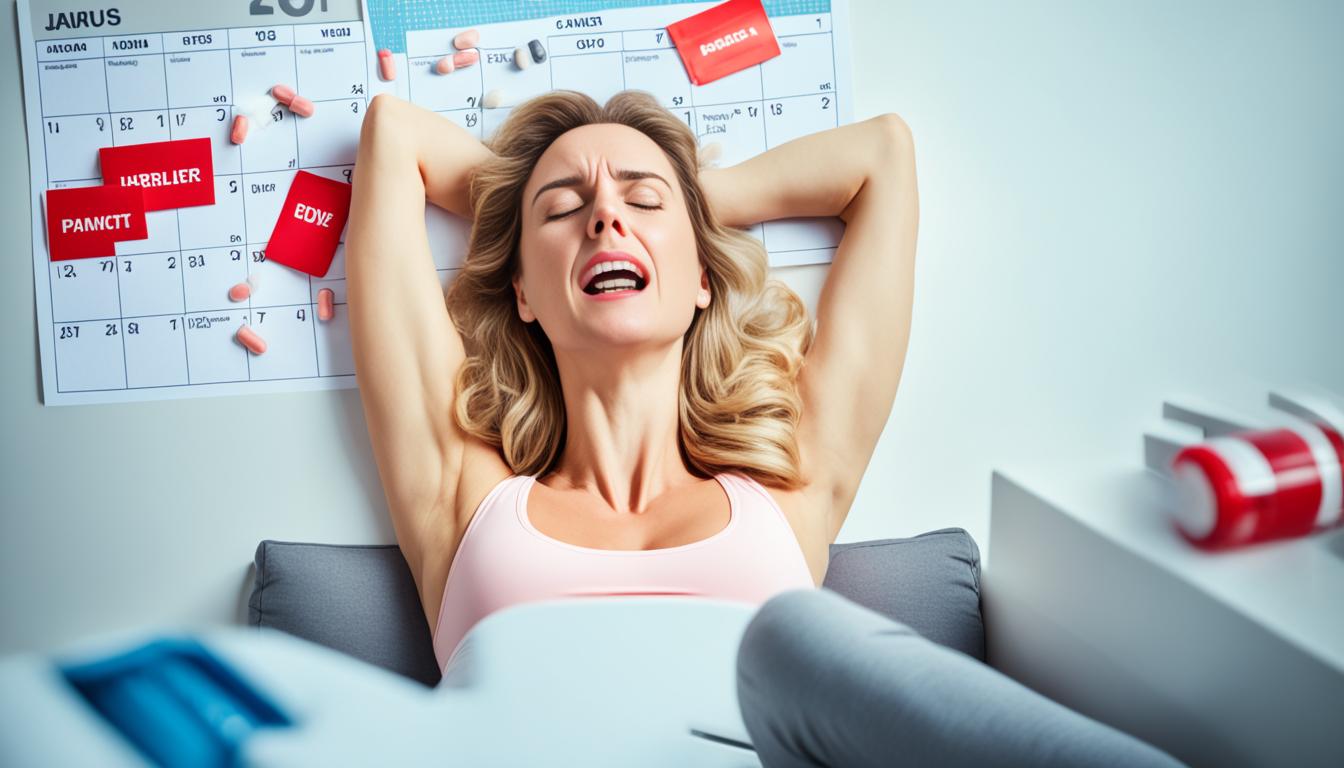Approximately 12% of women face premenstrual syndrome (PMS). This common issue brings many physical and emotional signs during the last part of their menstrual cycle. These signs can differ in how strong they are and how long they last, affecting a woman’s daily tasks and happiness.
Fatigue, mood changes, period pain, and hormone imbalances are typical signs of PMS. They can make it hard for a woman to do her daily activities and work.
Diagnosing PMS is not always easy because its signs can look like those of other health problems. For a better diagnosis, keeping a record of symptoms can show patterns and help differentiate PMS from other issues.
The exact reason for PMS is not known. Yet, shifting levels of hormones such as estrogen and progesterone seem to be a big factor. These shifts can mess with serotonin, a brain chemical, causing mood swings and other PMS signs.
Several treatments aim to help manage PMS symptoms and raise life quality for women suffering. A new option that looks promising is stem cell therapy. It targets hormone imbalances and seems to reduce PMS effects.
Key Takeaways:
- Premenstrual syndrome (PMS) affects approximately 12% of women and is characterized by physical and psychological symptoms.
- Common PMS symptoms include fatigue, mood swings, period pain, and hormonal imbalance.
- Keeping a symptom diary can aid in diagnosing PMS and differentiating it from other disorders.
- Hormonal changes, particularly fluctuations in estrogen and progesterone levels, are believed to contribute to PMS.
- Stem cell therapy is an emerging treatment option that can improve the quality of life for those with PMS.
Understanding Premenstrual Dysphoric Disorder (PMDD)
PMDD is a more intense form of PMS. It affects many women. It brings emotional and physical symptoms before the period.
Women with PMDD feel a lot of effects. These change their life and how they connect with others. It includes mood changes, actions, sadness, worry, getting mad easily, and not wanting to do things.
PMDD is quite predictable. Its signs show up before the period starts. This cycle of emotional and physical changes is key in PMDD.
Knowing PMS from PMDD and PME is vital for the right care. While PMS and PMDD have similar symptoms, PMDD is much tougher to deal with.
Treatment Options for PMDD
Treating PMDD uses many steps to help each person. The main aim is to lower symptoms and make life better.
Starting with new habits like working out and eating well is common. This can help manage hormones and make symptoms less severe.
If new habits don’t work alone, certain drugs might be needed. Doctors often prescribe SSRIs to balance serotonin and help with depression and anxiety.
It’s crucial for a woman with PMDD to see a doctor. They will make a care plan that fits and consider how bad the symptoms are, past health, and what the person wants.
| Treatment Options | Pros | Cons |
|---|---|---|
| Lifestyle modifications (exercise, diet, stress management) |
|
|
| Antidepressant medications (SSRIs) |
|
|
| Hormonal therapy (birth control pills, hormonal patches) |
|
|
Figuring out the best treatment can take some time. Every woman’s PMDD is different. So, the best care considers individual symptoms and needs.
Seeking help and trying different treatments can really help with PMDD. It can help women feel better and take back control of their lives.
Causes and Diagnosis of Premenstrual Syndrome
Premenstrual syndrome (PMS) is a complex issue influenced by many factors. Hormonal changes and neurotransmitter imbalances play a huge role. By understanding these causes, healthcare experts can better diagnose and treat PMS.
Hormonal changes during the menstrual cycle are a key factor. Fluctuations in estrogen and progesterone are linked to PMS. These changes can disturb neurotransmitters in the brain, especially serotonin. It affects our moods.
Research shows that serotonin deficiency can cause mood issues in women with PMS. Serotonin is known as the ‘feel-good’ chemical. Low levels can trigger depression, anxiety, and irritability.
Diagnosing PMS is tricky due to its many symptoms and their varying intensity. One helpful strategy is keeping a daily symptom diary. This can show patterns and help in diagnosis. It also aids in ruling out other health problems.
Health experts also look at other reasons for PMS symptoms, such as magnesium and calcium deficiencies. These can trigger PMS and must be considered during diagnosis.
Getting the diagnosis right is essential for the proper treatment. By knowing the causes and using good diagnostic tools, healthcare providers can better help women with PMS.
| Common Causes of Premenstrual Syndrome (PMS) | Associated Symptoms |
|---|---|
| Hormonal changes | Mood swings, fatigue, breast tenderness |
| Serotonin deficiency | Depression, anxiety, irritability |
| Magnesium and calcium deficiencies | Cramps, muscle aches, headaches |
Treatment Options for Premenstrual Syndrome
Treatment for premenstrual syndrome (PMS) aims to reduce its physical and emotional effects. Antidepressants, specifically SSRIs, are often helpful. They boost serotonin in the brain, which improves mood swings and depression linked to PMS. Hormone therapy, like contraceptive pills or vaginal progesterone, may be used to balance hormones and ease symptoms.
Other than medicines, complementary methods help with PMS signs. Relaxation activities, like deep breathing or meditation, lower stress. This can improve your overall mood. Supplements, such as calcium and magnesium, can also help. They’re known for reducing bloating, tender breasts, and irritability. Using both medical and alternative treatments together can take a holistic approach to managing PMS.
Getting the right PMS treatment might mean trying a few things. Everyone responds differently. So, finding what works for you could take some time. Speaking with a women’s health specialist is a great step. They can help you figure out the best plan for you. This way, you can work towards lessening your premenstrual symptoms.

